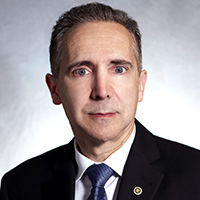Focus
September 26, 2025 | 14:06
Fed Amends Policy Framework… Again
Fed Amends Policy Framework… AgainThe evolution of the Fed’s framework reveals that monetary policy is very adaptable to perceived structural changes in the economy. |
|
Amid the Jackson Hole gathering last month, the Fed released its amended monetary policy framework. Since before the start of the year, potential changes had been the subject of public outreach, a research conference, and internal deliberations (which were subsequently reported in FOMC meeting minutes). Officially called the ‘Statement on Longer-Run Goals and Monetary Policy Strategy’, the framework is made up of the strategy, tools, and communication practices that the Fed uses to achieve its congressionally mandated goals of maximum employment and stable prices. It is, in effect, the blueprint for the conduct of monetary policy and the setting of interest rates. The framework is internally reviewed each year since it was first published in 2012, which was the year the Fed officially adopted the 2% inflation target. It became important to explain publicly how the conduct of monetary policy would be impacted. Leading up to the 2020 review, for the first time, the Fed directed a comprehensive public review of its policy framework via the three channels described above and committed to repeating the process “roughly every 5 years”. Last month marked the culmination of the second such public review. And like its predecessor, it resulted in major modifications to the framework. However, the alterations seemed mostly about reversing or watering down what was done in 2020. Below we briefly describe how the framework’s salient features have evolved over the past 14 years. Few changes in the first eight years |
In January 2012, the Fed officially (or publicly) adopted a 2% inflation target as measured by the annual change in the PCE price index. However, 2% had been an unofficial (not publicized) inflation target for many years before. Once made official, and after three months, total and core PCE inflation embarked on a multiyear run of sub-2% readings (Chart 1). Among the 98 observations between January 2012 and February 2020, 85% of total inflation readings were below 2% and it was 90% for core inflation. As time went on, the Fed was getting concerned about the potential for longer-term inflation expectations becoming unanchored (from 2.0%). In 2016, the framework was tweaked. Included was the phrase: “The Committee would be concerned if inflation were running persistently above or below this objective. Communicating this symmetric inflation goal clearly to the public helps keep longer-term inflation expectations firmly anchored…” (The underline parts were new). |
|
Meanwhile, all the statements said: “The maximum level of employment is largely determined by nonmonetary factors that affect the structure and dynamics of the labor market. These factors may change over time and may not be directly measurable. Consequently, it would not be appropriate to specify a fixed goal for employment; rather, the Committee’s policy decisions must be informed by assessments of the maximum level of employment, recognizing that such assessments are necessarily uncertain and subject to revision.” Here, the central tendency or median of FOMC participants’ projections of the longer-run unemployment rate were presented as an assessment tool, not a target. Finally, the frameworks said: “In setting monetary policy, the Committee seeks to mitigate deviations of inflation from its longer-run goal and deviations of employment from the Committee’s assessments of its maximum level. These objectives are generally complementary. However, under circumstances in which the Committee judges that the objectives are not complementary, it follows a balanced approach in promoting them, taking into account the magnitude of the deviations and the potentially different time horizons over which employment and inflation are projected to return to levels judged consistent with its mandate.” 2020’s changes |
For the first public review of the framework, certain developments were on the minds of policymakers and review participants. After a seven-year run with policy rates at the effective lower bound (ELB), a very gradual rate hike cycle (2015: 25 bps, 2016: 25 bps, 2017: 75 bps, 2018: 100 bps) proved to be too onerous for the economy (rates were cut 75 bps in 2019) (Chart 2). This raised concerns about policy rates remaining (permanently) too close to the ELB for comfort. Meanwhile, the unemployment rate was probing half-century lows around the 2018-2019 interval, yet broad inflationary pressures were absent (Chart 3). Core PCE inflation was barely able to hit 2.0% y/y and even that was fleeting. And there was evidence of job and wage gains becoming more socially disperse. In response to these developments, the new statement asserted: “The Committee judges that the level of the federal funds rate consistent with maximum employment and price stability over the longer run has declined relative to its historical average. Therefore, the federal funds rate is likely to be constrained by its effective lower bound more frequently than in the past… the Committee judges that downward risks to employment and inflation have increased.” The Fed switched to flexible average inflation targeting. After a period of persistent below-target inflation “appropriate monetary policy will likely aim to achieve inflation moderately above 2 percent for some time” so that inflation “averages 2 percent over time”. ‘Time’ was not defined (affording flexibility) and this was not intended to be a symmetric regime (whew!). |
|
The new statement also said: “The maximum level of employment is a broad-based and inclusive goal that is not directly measurable and changes over time owing largely to nonmonetary factors that affect the structure and dynamics of the labor market. Consequently, it would not be appropriate to specify a fixed goal for employment; rather, the Committee’s policy decisions must be informed by assessments of the shortfalls of employment from its maximum level...” By emphasizing ‘shortfalls from’ instead of ‘deviation around’ maximum employment this meant that a historically tight labour market would no longer (preemptively) trigger policy tightening unless it is associated with mounting inflation pressures. And “under circumstances in which the Committee judges that the [stable prices, maximum employment] objectives are not complementary, it takes into account the employment shortfalls and inflation deviations and the potentially different time horizons over which employment and inflation are projected to return to levels judged consistent with its mandate.” There was no longer a balanced approach: inflation would be allowed to run a little hotter than what would have been permitted previously if it results in getting even closer to maximum employment. 2025’s changesAfter the onset of the pandemic, the subsequent strong resurgence in demand butted against still-constrained supply to stoke inflation, which peaked at four-decade highs in the summer of 2022. Both total and core PCE inflation have remained consistently above 2% y/y since March 2021. As the unemployment rate revisited its pre-pandemic lows (it bottomed a tenth below at 3.4%), wage growth was surging at multi-decade highs. And in March 2022, the Fed commenced its most aggressive rate hike campaign (525 bps over 17 months) since interest rate targeting began in the 1980s and rates were still above 4¼% as of last month. These developments taken together cast the 2020 framework modifications as irrelevant for the conduct of monetary policy. The world, as the Fed understood it in 2019-2020, had fundamentally changed and, thus, so would the framework. The previous passage about the federal funds rate being constrained by its ELB more frequently, which raised the downward risks to employment and inflation, was dropped. The new phrase implicitly recognizes upward risks while still acknowledging the potential for ELB episodes: “The Committee’s monetary policy strategy is designed to promote maximum employment and stable prices across a broad range of economic conditions… The Committee is prepared to use its full range of tools to achieve its maximum employment and price stability goals, particularly if the federal funds rate is constrained by its effective lower bound.” The notion of flexible average inflation targeting, asymmetrically applied, was nixed. In his Jackson Hole speech, Chair Powell said: “As it turned out, the idea of an intentional, moderate inflation overshoot had proved irrelevant. There was nothing intentional or moderate about the inflation that arrived a few months after we announced our 2020 changes to the consensus statement.” We are back to flexible inflation targeting, where we were before August 2020 (always shooting for 2% with flexibility about how long to take to get there and where bygones are bygones). The idea of policy not reacting as aggressively to a tight/strong labour market compared with the reaction to observed ‘shortfalls’ from maximum employment was watered down. In the speech Powell said: “The use of ‘shortfalls’ was not intended as a commitment to permanently forswear preemption or to ignore labor market tightness. Accordingly, we removed ‘shortfalls’ from our statement.” The notion of not acting preemptively to a tight/strong labour was retained but couched. The statement now says: “Durably achieving maximum employment fosters broad-based economic opportunities and benefits for all Americans. The Committee views maximum employment as the highest level of employment that can be achieved on a sustained basis in a context of price stability.” Furthermore, it says: “If the Committee judges that the objectives are not complementary, it follows a balanced approach in promoting them… The Committee recognizes that employment may at times run above real-time assessments of maximum employment without necessarily creating risks to price stability.” Bottom Line: The evolution of the Fed’s framework emphasizes that the conduct of monetary policy is not etched in stone. But this has always been the case. Recall, for example, that the money supply and bank reserves used to be targeted at one point. The framework is adapting to changes in the economy and should make policy more effective in achieving its goals of price stability and maximum employment. |









